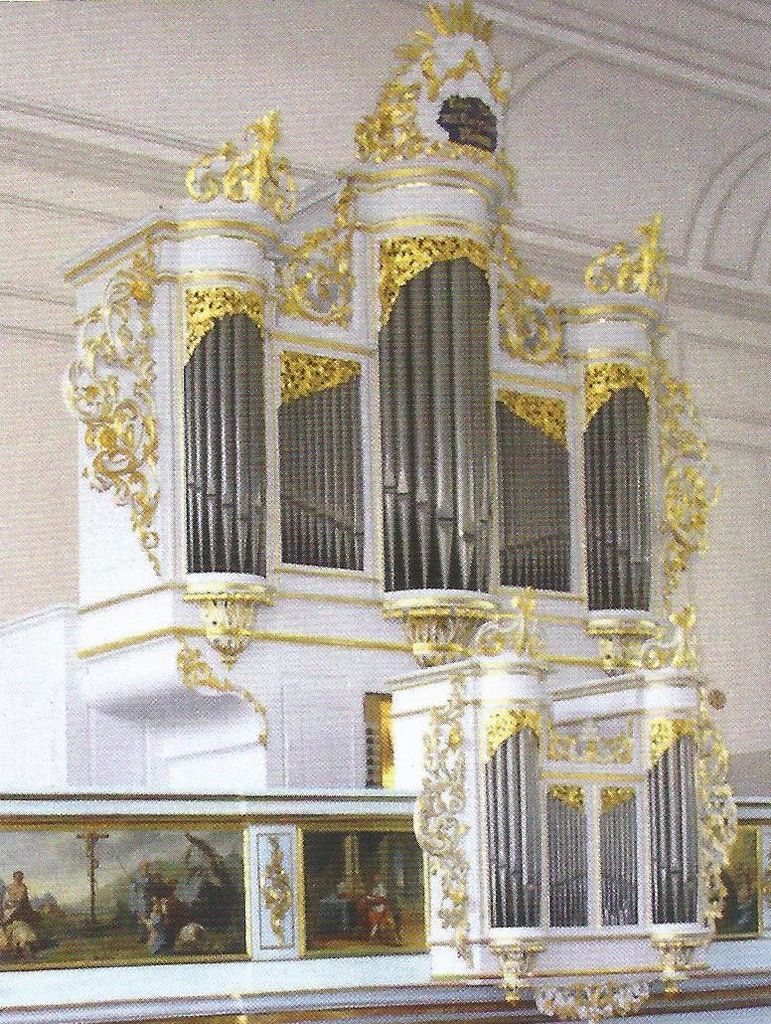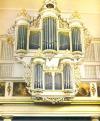Description complète d'orgue sélectionné

Strasbourg, France (Bas-Rhin (67)) - Église Sainte-Aurélie
Commune: Strasbourg
Région:Alsace
Adresse: 16 Rue Martin Bucer, 67000, Strasbourg
Description no.: 2000255.
Bâti par: Andreas Silbermann (1718)
Données techniques
Composition
Grand Orgue (C-c'''): Bourdon 16' (from E) - 2015, Montre 8', Bourdon 8', Prestant 4', Flûte 4' - 2015, Quinte 2 2/3', Doublette 2', Tierce 1 3/5' - 2015, Cornet 5 rangs (8') (discant) - 1718/2015, Fourniture 3 rangs (1') - 2015, Cymbale 3 rangs (2/3') - 2015, Voix Humaine 8' - 2015.
Positif (C-c'''): Bourdon 8', Prestant 4' - 2015, Nazard 2 2/3' - 2015, Doublette 2' - 2015, Tierce 1 3/5' - 2015, Fourniture 3 rangs (1') - 2015.
Pédale (C-d'): Soubasse 16' - 2015, Octavbass 8' - 2015, Trompette 8' - 2015.
Accouplements: Accouplement du Positif au Grand Orgue, Tirasse Grand Orgue - permanent.
Jouer conseils: Tremblant Doux.
Autres sources

Strasbourg, France (Bas-Rhin (67)) - Église Sainte-Aurélie
Commune: Strasbourg
Région:Alsace
Adresse: 16 Rue Martin Bucer, 67000, Strasbourg
Description no.: 2000255.
Bâti par: Andreas Silbermann (1718)
| Année | Facteur | Opus | Activité | 1718 | Andreas Silbermann | orgue neuf | 1765 | Johann Andreas Silbermann | restauration et expansion | 1870 | Martin Wetzel | changer la disposition | 1884 | Wilhelm Koulen | changer la disposition | 1911 | Manufacture Dalstein-Haerpfer | conversion | 1952 | Mühleisen Orgelbau | 4 | conversion | 2015 | Quentin Blumenroeder | reconstruction |
- The organ in the Église Sainte-Aurélie in Strasbourg was built in 1718 by Andreas Silbermann for the previous church building. It had two manuals and pedal. The current baroque church building was dedicated in 1765. Johann Andreas Silbermann transferred the organ and installed the three prepared stops, making the total number of stops at the time twenty. In 1790, the organ was repainted in colors that better suited the interior of the church. The stop list was modified by Martin Wetzel in 1865 and 1870, and by Wilhelm Koulen in 1884.
- In 1911, the organ was rebuilt by Dalstein-Haerpfer. The Positif was re-installed as Récit Expressif, the action was made pneumatic and the number of stops was increased to 33. The resulting instrument was one of Albert Schweitzer's favorite organs, where he recorded works by Bach and Franck's three chorales. In 1952 Ernest Muhleisen rebuilt and enlarged the organ again. It now had three manuals and pedal, with in total 52 stops. On the sides of the main organ case Muhleisen placed two new cases with the pipework of the pedal. There were still seven stops of Silbermann preserved in this large instrument.
- The original concept of Silbermann was reconstructed in 2012-2015 to the situation of 1768 by Quentin Blumenroeder. The organ case has also been restored to its original condition.
Données techniques
| Nombre de registres par manuel | |
| - Grand Orgue | 12 |
| - Positif | 6 |
| - Pédale | 3 |
| Nombre de jeux total | 21 |
| Transmission des clés | Mechanical |
| Transmission des jeux | Mechanical |
| Sommier(s) | Slider chests |
| Hauteur tonale | a' = 460 Hz |
| Presse de Vent | 72 mm |
Composition
Grand Orgue (C-c'''): Bourdon 16' (from E) - 2015, Montre 8', Bourdon 8', Prestant 4', Flûte 4' - 2015, Quinte 2 2/3', Doublette 2', Tierce 1 3/5' - 2015, Cornet 5 rangs (8') (discant) - 1718/2015, Fourniture 3 rangs (1') - 2015, Cymbale 3 rangs (2/3') - 2015, Voix Humaine 8' - 2015.
Positif (C-c'''): Bourdon 8', Prestant 4' - 2015, Nazard 2 2/3' - 2015, Doublette 2' - 2015, Tierce 1 3/5' - 2015, Fourniture 3 rangs (1') - 2015.
Pédale (C-d'): Soubasse 16' - 2015, Octavbass 8' - 2015, Trompette 8' - 2015.
Accouplements: Accouplement du Positif au Grand Orgue, Tirasse Grand Orgue - permanent.
Jouer conseils: Tremblant Doux.
| Autres données des dispositions | |
|---|---|
| Autres dispositions |
|
| Références |
|
| Enregistrements |
|
| Lièns |
https://www.itineraires-silbermann.org/strasbourg-sainte-aurelie/ |
- Jörg R. Becker
- Bert Wisgerhof
 |
 |
 |
